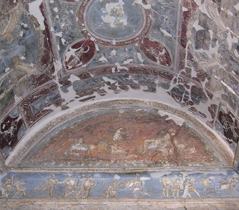 1
1Sacrarium
There is also evidence that in addition to domestic shrines some houses contained dedicated sacraria (sanctuary rooms) linked to specific forms of cult worship. According to Fabrizio Pesando, The House of the Ilion Sanctuary used paintings and stucco-work in the sacrarium to make clear “references to the occupant's piety, the exaltation of their presumed origins and their celebration of the spiritual.” (fig.1)
In the apex of the vaulted ceiling of the Ilion sanctuary is a medallion depicting the abduction of Ganymede, a mythological image associated with apotheosis and immortality (fig. 2). Representations of this theme were commonly placed at ceiling apexes and its presence here is consistent with Pesanado’s view that the sacrarium was used for cult worship, possibly relating to the Trojan or familiae Troianae ancestry. This view is supported by wall-paintings and stucco relief panels that depict Homeric tales venerating Hector, who is also thought to be the deified hero-protector of the house.
A room in Casa di M. Fabio Rufo may also have been a sacrarium. Initially the room appears to have been dedicated to the cult of Venus Genetrix, who is depicted as if entering the room with a winged putto on her shoulder (fig.3&4). Somewhat mysteriously, her image was later overpainted by a nondescript composition featuring a candelabra at its centre. The far superior earlier painting would have remained covered had it not been for the 62AD earthquake or the eruption of 79AD, which caused the second layer of plaster and paint to detach. Its use as a sacrarium is difficult to prove, but conversely why would a small, dimly lit room deep within the house have possessed such a fine cult wall-painting? The overpainting may suggest a change of cult affiliation that overrode other aesthetic considerations. Superstition and cult allegiance underpinned much of the social fabric of Pompeii and could well have motivated the covering up of what is probably one of the most beautifully executed paintings in the whole of Pompeii. The paintings cult significance is also attested to by the fact that when overpainting occurred the surface of the painting was not pitted in order for the new layer of plaster to key to the previous layer, as was normal (fig.5). Susan Walker in her essay "Cleopatra in Pompeii ?" makes a tangible case for linking Cleopatra VII Philopator with the cult image of Venus Genetrix depicted in Casa di M. Fabio Rufo wall-painting. If this was the case, it might help to explain its overpainting, which may have taken place after Cleopatra's demise at the hands of Octavius. (Walker 2008 : 35-48)
 1
1 1 Sacrarium, Casa del Sacello Iliaco, Pompeii
2 Ganymede roundel, Sacrarium, Casa del Sacello Iliaco, Pompeii
3 Casa di M. Fabio Rufo, Pompeii
4 Casa di M. Fabio Rufo, Venus emerging from between double doors
5 Example of pitted wall ready for replastering and painting
|